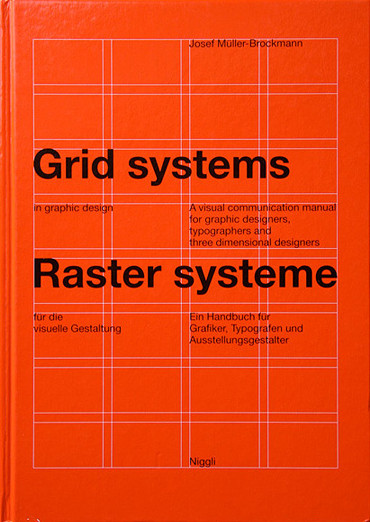Jan Tschichold: The New Typography: A Handbook for Modern Designers (1928/1995)
Filed under book | Tags: · book, design, graphic design, technology, typography

“Since its initial publication in Berlin in 1928, Jan Tschichold’s The New Typography has been recognized as the definitive treatise on book and graphic design in the machine age. At once a key theoretical document of Central European modernism between the world wars and an invaluable source of working principles for the practicing designer, this classic work enjoys the reputation among book artists that Le Corbusier’s Toward a New Architecture has long held among architects.
The book’s legendary renown is certain to increase with the long-overdue appearance of this first English translation, published in a form that reflects Tschichold’s original typography and design. Ranging from theoretical discussions of typography in the age of photography and mechanical standardization to practical considerations in the design of business forms, The New Typography remains essential reading for designers, art historians, and all those concerned with the evolution of visual communication in the twentieth century.”
First published in German as Die neue Typographie: Ein Handbuch für Zeitgemäss Schaffende, Bildungs verband der Deutschen Buchdrucker, 1928.
Translated by Ruari McLean
With an Introduction by Robin Kinross
Publisher University of California Press, 1995
A Centennial Book
Weimar and Now: German Cultural Criticism series, 8
236 pages
via Jindra Kratochvil
Review: Victor Margolin (Print 1996).
Comment (0)Josef Müller-Brockmann: Grid Systems in Graphic Design / Raster Systeme für die Visuele Gestaltung (1968) [EN/DE]
Filed under book | Tags: · design, graphic design, typography, visual communication

This book is suitable for those who work with automated text and image design. It shows examples of working correctly on a conceptual level. Exact directions for using all of the grid systems presented (8 to 32 grid fields) are given to the user. These can be used for the most varied of projects. The three-dimensional grid is treated as well. Put simply: a guidebook from the profession for the profession.
The development of organizational systems in visual communication was the service and the accomplishment of the representatives of simple and functional typography and graphic design. In the 1920s in Europe, works already arose in the areas of typography, graphic design and photography with objectified conception and rigid composition. In 1961 a brief presentation of the grid with text and illustrations appeared for the first time in an earlier book by the author. Articles published mainly in trade journals then followed.
This book now attempts to close a gap by giving examples and exact directions to the professional concerning all grid problems that can occur. The author, a world-renowned professional, thus offers his colleagues the tools to solve problems more easily.
Grid Systems in Graphic Design: A visual communication manual for graphic designers, typographers, and three dimensional designers / Raster Systeme für die Visuele Gestaltung: Ein Handbuch für Grafiker, Typografen und Ausstellungsgestalter
Publisher Niggli Verlag, 1968
176 pages
Grid Systems in Graphic Design / Raster Systeme für die Visuele Gestaltung (English/German, 1968, no OCR)
Sistemas de retículas / Sistemas de grelhas (Spanish/Portuguese, trans. Ángel Repáraz Andrés / Fernando Peraira Cavadas, 1982, added on 2013-12-11, removed on 2017-3-9 upon request of the publisher)
Franz Schulze: Mies van der Rohe: A Critical Biography (1985/1989) [Italian]
Filed under book | Tags: · architecture, bauhaus, biography, design

Schulze’s acclaimed biography is the first full treatment of the master German-American modern architect. Schulze traces Mies’s European career in its progression to avant-garde modernism—where his work was materially rich but of modest scale—to his second maturity and world renown in the United States, where he invented a new architectural language of “objective” structural expression. Among the authors’ most exciting new discoveries is the massive transcript of the early-1950s Farnsworth House court case, which discloses for the first time the facts about Mies’s epic battle with his client Edith Farnsworth. The book reveals new information about his relationships with women, including the nature and breakup of his marriage to the wealthy Ada Bruhn, his close professional and personal ties to the gifted designer Lilly Reich, and new details from a series of illuminating interviews with his American companion, Lora Marx. This edition also gives voice to dozens of architects who knew and worked with (and sometimes against) Mies—many of them from the unique oral history collection of the Art Institute of Chicago’s Department of Architecture.
This comprehensive biography tells the compelling story of how Mies and his students and followers created some of the most significant buildings of the twentieth century.
Originally published by University Of Chicago Press, in association with the Mies van der Rohe Archive of the Museum of Modern Art, 1985
Translated to Italian by Mara De Benedetti, published as Mies van der Rohe by Editorial Jaca Book spa, Milan, April 1989, ISBN 8816600888, 344 pages.
PDF (no OCR)
Comment (0)
